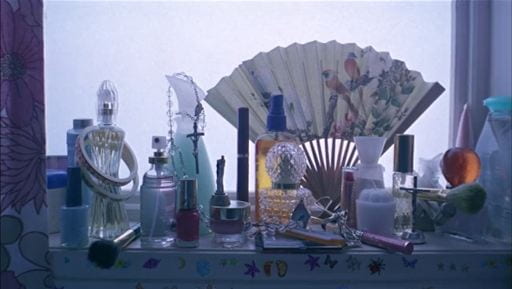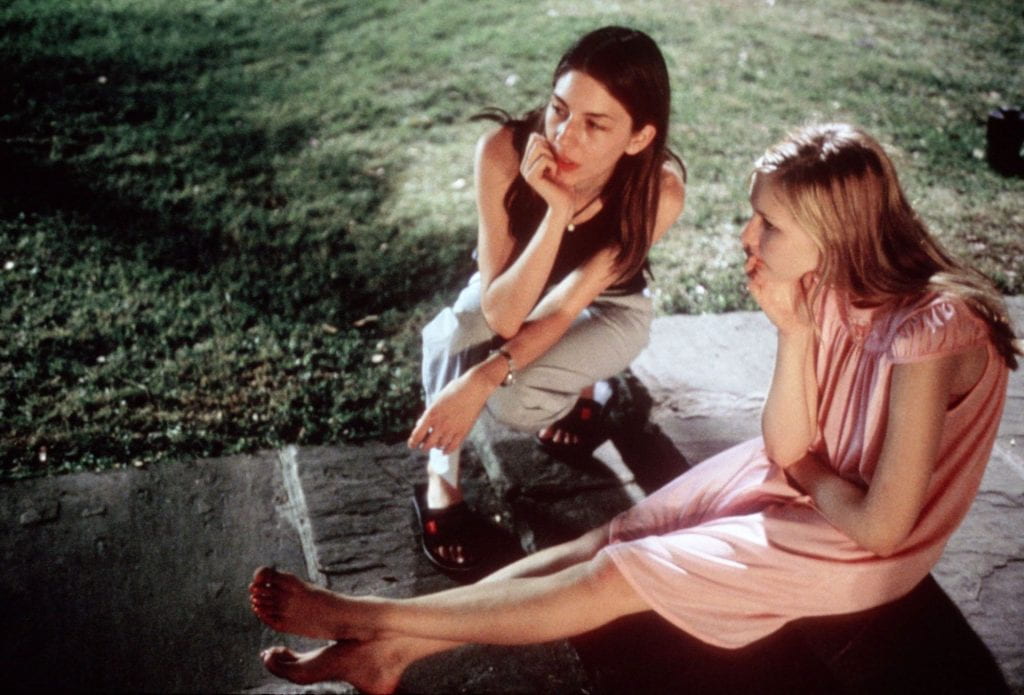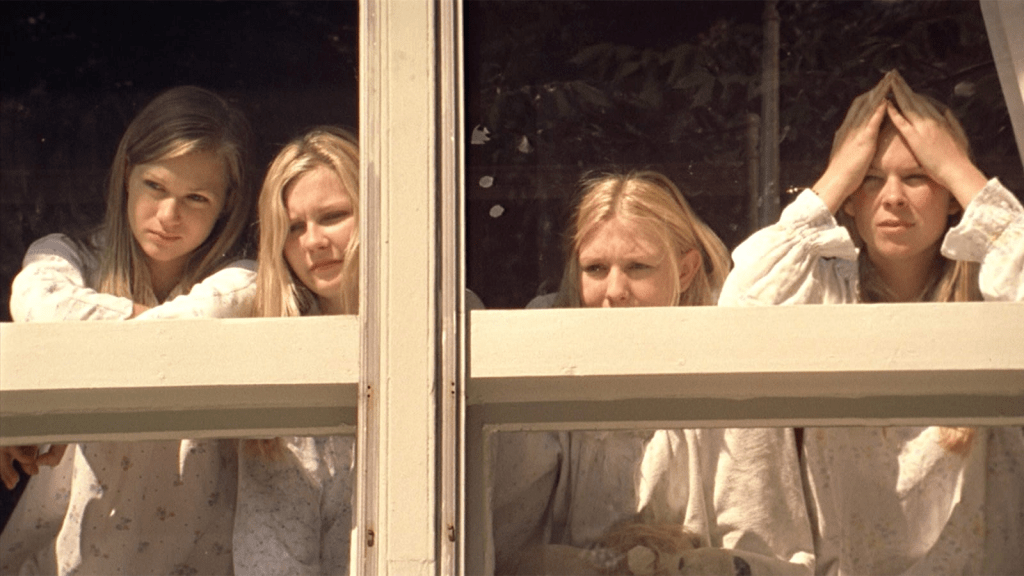
The Virgin Suicides
Noni Ford examines how both the Jeffrey Eugenides novel The Virgin Suicides and Sofia Coppola’s adaptation portray the disconnect between the male narrators and the sisters at the center of the story.
“We saw the light in her eyes we have been looking for ever since.”
— The narrators, The Virgin Suicides by Jeffrey Eugenides
The best way to understand the tone and the themes of Sofia Coppola’s directorial debut is by listening to Air’s “Playground Love,” the first song on the film’s soundtrack. As Thomas Mars sings lazily but emotionally of a romance that’s half limerence and half infatuation a picture forms of a boy in love with a girl he only calls his “playground love.” She has no other name, no other features, and there are contradictions in the lyrics as sometimes he seems like he’s accepted there’s an impermanence to this relationship and then in the next line he’ll reveal a devotion that goes further than just a fling. This gives you a taste for the longing, mystery, and the raw emotions of youth you’re about to see as the story unfolds.

Sofia Coppola and Kirsten Dunst
It’s easy to sum up the film The Virgin Suicides by saying it primarily follows a gaggle of neighborhood boys who during their childhood become fixated on the Lisbon family and their five daughters. But that’s a little too simplistic of a reading. While there’s plenty of emphasis on the male gaze of the boys as they create a fantasy version of each of the girls, there’s also a bit of a mirror being held up to them. Even though the film is narrated by the boys and they appear ever present in most scenes, we still get to catch glimpses of the Lisbon girls. Between the real and imagined facets of their lives is the truth and we can see it if we — the audience — look close enough.
The source material of the film, Jeffrey Eugenides’s book of the same name, also dives deeper into the levels of fanaticism the boys have as they retrace mementos of the Lisbon’s that they collect and track down members of the community for interviews. Their conception and reading of details are sometimes colored by their current age and life experience and sometimes they reveal memories preserved in their minds with minimal dissection. While reading it is easy to get sucked into the search for clues and memories, there are times when one element will snap you out of the perspective. There’s a throwaway line where they remark on some of the physicality of the former boys, now men, in the group. It makes you realize this isn’t an expedition of children, but rather men tied together by this never-ending quest to deliver answers to this conundrum. This story seems the only thing that truly connects them, and although there’s no gleeful edge to their amateur investigation there’s something sickening about their prolonged focus on these girls. It’s not just them, though, as they make their way through a significant portion of meetings and question almost anyone who had a direct experience with the girls.

Kirsten Dunst as Lux
These girls were not just the subject of the boys’ focus but seemed to have been noticed or at least remembered in detail by most people in the neighborhood. Largely due to their family’s fate, there is obvious interest in them that probably spiked after the main events of the film occurred. Still, there are moments where even in the book you wonder why they have held so many in thrall. When reflecting on their looks, the boys are quick to talk about some of their imperfections, and yet as the story goes deeper those disappear and you feel as if they could be every teenage girl ideal rolled into one. They wear out-of-fashion and somewhat formless clothing and yet every boy yearns for them at the school dance and they turn heads as they walk into school. Tragedy has touched them by the end of the first act and they behave as though it hasn’t and that seems to be what gets everyone to take notice at first. More than that, though, they don’t ever really reveal their inner thoughts and feelings, inviting intrigue and mystery.
Coppola does something ingenious with her adaptation, though, as she makes the girls matter to us. Therese, Mary, Bonnie, Lux, and Cecilia are significant to us because they are real. In scenes of minimal dialogue and lingering shots we see ourselves in these girls. We see ourselves in Lux alone on the football field, we see ourselves in them getting ready to go to their first big school dance, and we see ourselves in Cecilia vacantly watching the neighborhood and its inhabitants as they pass by her. Coppola allows us in these scenes to see past the narrative of the boys in order to properly see the truth of the girls’ emotions.
It’s never reflected on by the narrators, but in their distance from the Lisbons they are in fact exacerbating the sense of loneliness and isolation the girls feel. They are not there for them, they are there to observe. They have no misery to commemorate with the sisters; indeed their lives seem exempt from anything too terrible and so they gawk at a misery they cannot feel. They get close enough to examine it but don’t want to hang around too long in it. When they begin exchanging messages and ultimately come to the house late at night at the behest of the girls, they imagine a rescue mission with themselves as saviors. Yet they could have saved them in a million ways before then, by befriending them or even rescuing them before that particular night. The way the boys monitor the house, it seems like they are far away from it all, but they are just across the street, next door, or a few houses down. The separation is purely in their heads and, perhaps due to the fact that it’s evident the family is disintegrating, and no adults are doing anything, they believe that it is appropriate to talk about the family but not to intervene.

The Lisbon sisters
They are children when most of the events of the film occur, but even as adults — although they reflect on all of the details of this family — they still seem not to understand what could have been done to help the situation. Near the end of the film the boys all gather, now teenagers and closer to the precipice of adulthood, to stare at what remains of the Lisbon house. A haunting monologue is delivered in which an assertion is made that the boys had loved the girls. It’s a line in the book that makes you pause, and does so in the film too. Did they love them? It seems inconceivable; they watched them, they did not know them. Between seeing and being seen, there is a gulf and it’s often one people understand as they grow into adulthood. Yet the boys are adults by book’s end; they have wives and children and have lived out their lives past the story and still they believe what they felt was love. It could be that it’s not for us as an audience to decide what the boys felt or feel. Love feels kinder to accept as a feeling than anything else the boys could claim. Is it a mix of guilt and longing that makes love feel easier to admit than obsession? In the end, there’s no last thing needed to “solve” the mystery, no final clue or reveal; all we have are artifacts and snatches of the girls. The story will never be tied up or closed because these boys, this neighborhood, and even we will always be on the outside looking in.
The Virgin Suicides will be screened at IU Cinema on May 9 as part of the I Love the ’90s series.